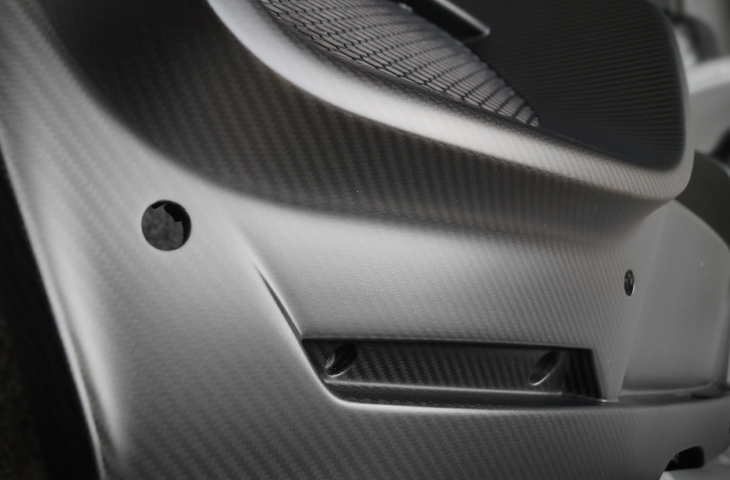Carbon Fibre Finish & Care
We offer a range of finishes for our own-brand parts and client projects, as described on this page.
A-Surface & B-Surface
The A-surface is the seen visual surface of a part, typically described as the 'tooled' surface and as such is of the highest quality. The B-surfaces are the unseen surfaces of the part, typically the opposite side of the A-surface (such as the insides of a part). A-surface finishes are explained below (polished, sanded matte and painted/clear coated). The B-surface typically gives a wrinkled looked finish (as a result of bagging during manufacture).
The images below of a Carbon Fibre bonnet vent shows the inside B-surface (left) and the polished A-surface (right);

If a smoother B-surface finish is required, then peel ply can be added to provide a wrinkle free textured surface (image below, left). If desired, peel ply can be used as an A-surface finish also. A typical application would be for steering wheel paddles where the texture of the peel ply provides extra grip (image below, right);

Finishes - Polished
As standard, all our products are machine-polished using 3M products to give a shiny hard-wearing finish. After polishing, black wax is applied to all visual surfaces to provide extra protection from the elements however, it must be noted that a polished finish is not UV stable so if the part is an exterior part it may be desirable to have a clear coated (lacquered) finish or colour painted (see below). It is recommended, for polished parts, to regularly apply UV wax (such as KLEERS, STP Son Of A Gun Protectant or Armour-All Protectant Spray) to protect the visual surface.
Texallium products are particularly liable and can yellow in only 2 – 6 weeks. The epoxy resin will ‘yellow’ with prolonged exposure to UV radiation and material strength properties will slowly deteriorate.
Examples of a polished finish:


Finishes - Sanded Matte Commercial/Sand for Paint
For some commercial products where final finish is not important or a gloss shiny finish is not required, Carbon can be sanded to a P600 finish which will give a smooth matte appearance. One of the benefits of this finish is that scratches can be easily sanded out (though care has to be taken not to sand through the Carbon weave resulting in an unsightly appearance).
If a part is to be painted by a third party, then this option will need to be specified at checkout as our default finish is polished. There is no extra cost for sanding for paint.
Example of a P600 sanded matte finish:

Finishes - Painted/Lacquered
We recommend exterior products or those exposed to constant UV are either colour painted or clear-coat lacquered. For deep shine and UV protection we recommend sanding and then finishing with automotive 2K Epoxy-Urethanes, Polyurethanes or Acrylic Spray Lacquers. The surface should be sanded so no gloss can be seen between warp and weft. The surface should be sanded with 180, 240 then 320 grit paper and then a cleaning solvent used to remove grease or dirt prior to paint application. Several coats may be required (normally 3 to 4 light coats) to avoid pin-holing, common with painting composite products. Pin holes may be filled in carefully with a brush, then wet-sanded for a final application of 3 thin coats.
Example of a gloss 2K clear coat lacquer finish on a 225mm chord angled wing end plate;

Example of matte clear coat finish on a rear diffuser/bumper;


Example of a colour-matched painted finish, a Carbon Fibre boost tube on a Lotus 340R;
















